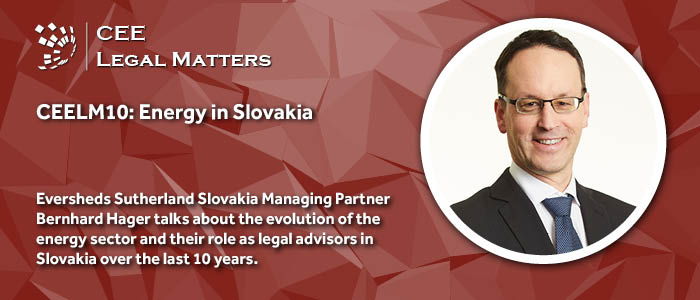Eversheds Sutherland Slovakia Managing Partner Bernhard Hager talks about the evolution of the energy sector and their role as legal advisors in Slovakia over the last 10 years.
CEELM: What types of energy projects have you worked on the most over the last 10 years? How has this changed over the past decade?
Hager: Slovakia witnessed a renewable energy boom in 2010-2011, followed by a quieter period. We then focused on updating and selling projects, particularly in photovoltaics and biomass. The challenge of securing energy for industry remained constant. While the term ESG was not in use back then, projects were essentially driven by social responsibility, aiming to reduce carbon footprints.
At later stages, the predominant focus was on ESG. A decade ago, energy law, especially in renewables, was considered exotic, but now it has become mainstream. We transitioned from being more of a boutique operation in this field to facing competition from the major firms.
Additionally, in the past year, our primary focus has been on energy resilience. Escalating prices led to difficulties for our clients in meeting their energy expenses. The spot market saw electricity prices rise dramatically from EUR 50 per megawatt-hour to an average of EUR 600 per megawatt-hour, reaching EUR 1,000 per megawatt-hour on the spot market in some cases. We had to renegotiate power purchase agreements and advocate for state aid and subsidies, and for many, the decision of whether to temporarily shut down plants became a critical consideration.
CEELM: Throughout this time, what were the most intense periods for you and your team, and what factors do you think contributed to those challenges?
Hager: Over a decade ago, around 2010-2011, a wave of investors was drawn to Slovakia due to attractive feed-in tariffs. Subsequently, the market stabilized, and our role shifted to supporting these developers. The supply crisis in 2014-15 and the recent one were significant challenges. In the last two to three years, numerous projects were developed aimed at decreasing reliance on foreign energy, specifically oil and gas from the East. The introduction of the EU Emission Trading Scheme (ETS) and the continuous reduction of free allocation of emission allowances throughout the years were also crucial developments, requiring heavy industries to reduce carbon dioxide emissions.
CEELM: How have the profiles of energy projects evolved over the last decade, and what trends do you observe in terms of the energy project categories and investments?
Hager: In the past, renewables were considered more unconventional and were largely introduced due to international obligations. Over time, green energy became a mainstream concern, compelling firms of all sizes to address it. Currently, our focus extends beyond merely introducing a few photovoltaic panels as we actively assist both light and heavy industries with comprehensive energy needs, ranging from measures to energy efficiency measures for lightbulbs to supply chain issues.
CEELM: In terms of client needs, do you see new expectations emerging, and if yes, what are they?
Hager: Today, companies increasingly demand more sustainable and green energy solutions. If you consider a plant from years ago, even though energy constituted 80% of their costs, it was managed as a somewhat administrative function, and in the past, as energy lawyers, we typically met with plant managers. Today, we find ourselves in prominent meeting rooms engaging with CEOs or CFOs. Our role has also evolved to encompass a more comprehensive involvement in energy projects, with expectations for us to know and address every aspect. Energy is no longer a standalone issue – rather it is a holistic concern that requires us to comprehend banking, reporting, and technical intricacies. When clients approach us, they expect our insight into how the project will be reflected in the ESG report from the very beginning.
CEELM: From a legislative/regulatory standpoint, what have been the main landmark moments in the past decade?
Hager: The market underwent a significant transformation with the introduction of the feed-in tariff for renewables, however, after 2011, the state decided to discontinue the project by eliminating the feed-in tariffs, citing an abundance of projects in Slovakia.
Meanwhile, EU regulations focusing on energy efficiency and the ETS gained prominence, and there was a substantial emphasis on ESG and reporting obligations. On the other hand, we are still waiting for the streamlining of permitting procedures to facilitate easier and faster implementation of projects.
CEELM: What lies ahead for the energy sector? How do you anticipate the industry evolving?
Hager: In a decade, I expect the highlight would be implemented projects aimed at reducing emissions. Achieving zero emissions will be a reality for many industries, and where it is not possible, decarbonization and offset projects like carbon farming and carbon forestry will take place. In addition, I believe there will be more efforts for independence from third countries’ energy supply. Energy autonomy in the EU will be a significant issue, aiming to avoid exposure to geopolitical issues as we currently experience in Eastern Europe.
Eversheds Sutherland is CEE Legal Matters' Practice Leader for Energy in Slovakia for 2024 – learn more here.
This article was originally published in Issue 10.11 of the CEE Legal Matters Magazine. If you would like to receive a hard copy of the magazine, you can subscribe here.
